Do your daily operations genuinely reflect your big-picture vision? Strategic execution translates your company’s long-term goals into everyday actions, ensuring everyone’s work directly contributes to your overall success.
Many businesses invest heavily in strategic planning yet struggle when it’s time to bring those plans to life. Maybe projects stall midway, productivity unexpectedly dips, or costs start creeping upward. Often, these setbacks happen because there’s a gap between the original plan and the daily execution. Teams can quickly lose momentum without clear, actionable steps to follow.
Bridging that gap becomes easier when your team has the right tools to stay aligned and focused. This article explains how to take plans into effective execution and how tools like monday work management can help simplify the process by offering clarity, coordination, and steady progress.
What is strategic execution and why does it matter?
Strategic execution is the disciplined process of turning business strategies into concrete outcomes by aligning actions, resources, and decisions across every level of your organization.
Here’s how strong strategic execution benefits your organization:
- Increased revenue: Accelerating product launches helps you reach the market sooner, capturing customer attention ahead of competitors and establishing early brand loyalty.
- Stronger market presence: Cohesive teams united around shared goals consistently deliver clear, unified messaging and customer experiences, strengthening your brand’s position in the marketplace.
- Improved efficiency: Allocating resources strategically prevents overspending and reduces waste, ensuring resources — whether people, time, or budget — are invested precisely where they’ll deliver maximum impact.
You can gauge the effectiveness of your execution by regularly tracking goal completion rates, milestone achievements, and resource management efficiency. Regular check-ins provide accountability, allowing quick adjustments to keep your plans on track.
Strategic execution across different industries
Strategic execution isn’t one-size-fits-all. It looks different depending on your industry, business size, goals, and more. For example:
- Technology companies often focus on rapid innovation cycles, emphasizing agility and flexibility in execution processes.
- Healthcare organizations prioritize regulatory compliance and patient safety, making careful resource allocation and risk management crucial.
- Retail businesses emphasize real-time inventory management and customer demand forecasting to ensure smooth day-to-day operations.
Understanding these nuances helps tailor your approach, ensuring your strategy remains practical, relevant, and impactful for your industry.
Want to learn more about how resource planning can impact your business? Read about how enterprise resource planning (ERP) will form the backbone of your business.
Why smart planning makes strategic execution easier
Effective execution begins with thoughtful, realistic planning. Have you ever set goals that sounded great initially but proved impractical once you got started? Overly ambitious strategic goals can exhaust your team, while overly cautious ones limit growth.
The key is validating assumptions about market conditions, customer expectations, or competitor activities early to avoid costly missteps later.
For instance, if a consumer goods brand discovers early on that customers prefer affordable options rather than premium ones, they can quickly adjust pricing and marketing strategies. This proactive approach prevents wasted resources and builds team confidence, improving overall engagement.
3 reasons why good business strategies stall
According to a Gartner study, 53% of organizations fail to execute their strategies successfully, but several studies throughout the past five years have shown this figure to be as high as 90%. Even strong strategies falter without effective communication, proper coordination, and the right tools. Here’s how these issues typically manifest and how to avoid becoming part of the statistics.
1. Poor coordination and unclear priorities
When teams lack clarity on priorities or responsibilities, even the best-planned projects can stall. For example, when HP merged with Compaq in 2002, they underestimated the need to align their corporate cultures and integrate systems effectively. Employees struggled to coordinate, mistrust grew, and the merger’s intended benefits took years longer than expected.
Common signs of poor coordination include:
- Ambiguous ownership leading to delays
- Confusion around individual responsibilities
- Departments duplicating work due to isolation
- Inconsistent communication causing inefficiency
To address these challenges, leaders must regularly communicate updates, define roles, and actively seek employee feedback. Regular town halls and cross-departmental check-ins foster dialogue and unity.
2. Limited oversight and delayed responses
Rapid growth can make monitoring progress increasingly difficult. Without real-time insights, leaders can’t promptly handle emerging issues, resulting in costly setbacks. Consider UPS’s 2013 holiday shipping strategy promised timely deliveries but didn’t account for overwhelming demand. The lack of oversight into logistics led to delays, customer dissatisfaction, and significant financial impacts.
Oversight challenges often include:
- Fragmented reporting systems that slow decision-making
- Difficulty identifying and mitigating risks promptly
- Slow detection of emerging issues
To overcome this, use centralized dashboards and management tools that provide instant visibility, allowing leaders to act decisively.
3. Inefficient processes and outdated tools
Many businesses still rely on outdated tools, like spreadsheets, leading to inefficiencies, bottlenecks, and errors. Kodak, for instance, invented the digital camera in 1975 but didn’t pivot due to management’s resistance and reliance on legacy processes. This strategic misstep allowed competitors to dominate the digital market, eventually leading Kodak into bankruptcy in 2012.
Indicators of process inefficiency include:
- Poor resource allocation (overloaded or idle employees)
- Frequent data inaccuracies or loss
- Slow, manual tasks causing frustration
Internal resistance to adopting new processes or tools can compound these issues. Your teams may stick with outdated methods because they’re familiar, despite clear drawbacks. Overcoming resistance involves:
- Demonstrating how new tools simplify everyday tasks
- Providing thorough training and ongoing support
- Sharing relatable scenarios illustrating the benefits of change
Addressing these barriers head-on ensures smoother execution, enabling your business to achieve its strategic objectives effectively.
6 key steps to achieve successful strategic execution
Putting strategy into action might feel intimidating, but a structured approach simplifies the process. Follow these 6 steps — ensuring leadership drives and supports each stage — to smoothly bring your vision to life:
1. Plan realistically from the start
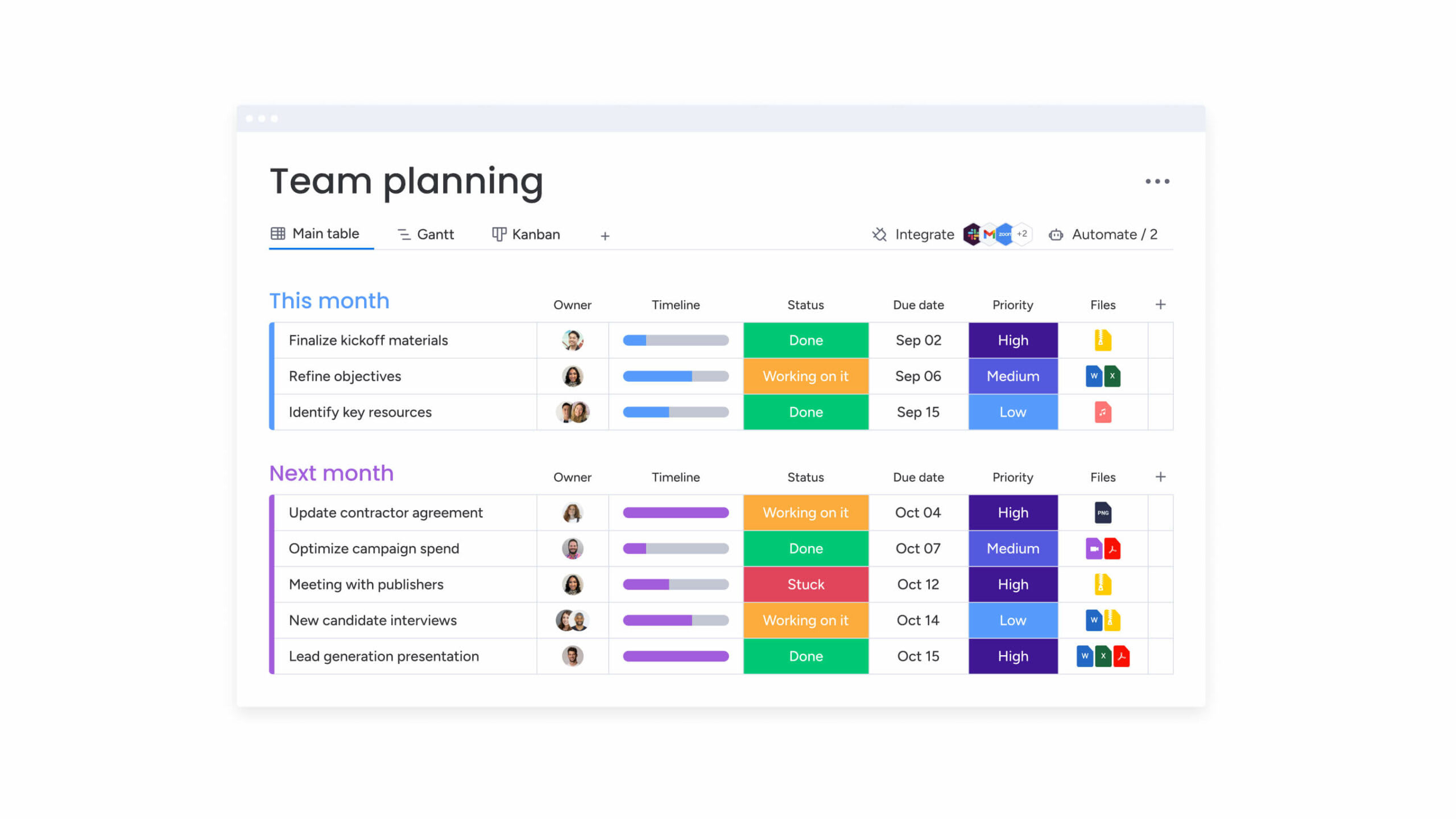
Leadership should actively sponsor the planning process, reinforcing its importance from the top down. Executives and managers should:
- Define specific, achievable outcomes.
- Choose a few critical metrics for success.
- Outline straightforward, actionable tasks.
- Schedule regular checkpoints to monitor progress.
- Test assumptions quickly (market conditions, competition) to prevent surprises.
Avoid overthinking and analysis paralysis by confirming assumptions quickly so you can confidently move forward.
Realistic implementation timelines
Expect meaningful execution improvements within months, not weeks.
- 1-3 months: Initial setup, including tool selection, team training, and process creation
- 3-6 months: Tangible benefits, such as smoother project completions and enhanced efficiency, typically appear
- 6-12 months: Full integration and consistent strategic optimization
Setting these realistic expectations ensures sustained commitment and prevents early frustration.
2. Set meaningful and aligned goals
Goal-setting succeeds when leadership actively aligns organizational objectives and visibly supports their pursuit. Executives and middle managers should:
- Link individual and team objectives to overarching business goals.
- Assign explicit responsibility to remove confusion around ownership.
- Regularly review goals to ensure practicality and alignment with available resources.
- Confirm teams have the necessary skills, resources, and management support.
Employees perform better when they understand their impact on the bigger picture. Use our goal tracker template to get started!
3. Foster open communication
Clear communication starts with leadership. Executive sponsorship and middle management alignment are crucial — leaders must actively model openness by regularly sharing strategy updates and inviting honest feedback. Here’s how to ensure clarity and engagement:
- Leaders should consistently communicate objectives right from the outset.
- Foster two-way dialogues — actively invite input rather than relying on top-down updates.
- Conduct regular team meetings focused explicitly on strategic progress.
- Use brief surveys or informal check-ins to gather ongoing feedback.
Leadership’s visible commitment to transparent dialogue ensures that everyone remains informed and motivated.
4. Streamline tracking and reporting
Manual tracking or scattered spreadsheets create confusion and slow responses. Simplify tracking in the following ways:
- Use centralized dashboards or user-friendly software to monitor progress.
- Make status updates quick and easy for your team.
- Define straightforward KPIs for accurate progress measurement.
Simple tracking tools let you quickly spot and solve problems as they arise.
5. Consistently assess performance
Effective performance management depends on active leadership participation. Executives and middle managers should:
- Explicitly link employee performance evaluations to strategic priorities.
- Hold frequent, informal check-ins rather than relying solely on annual reviews.
- Use intuitive tools that facilitate regular, meaningful conversations.
Leadership’s active role in performance management helps employees understand their impact, significantly boosting motivation and productivity.
6. Reward strategic achievements
Leaders should visibly celebrate strategic milestones, reinforcing commitment and enthusiasm across teams. Executives should:
- Tie bonuses, promotions, and recognition directly to strategic achievements.
- Explain the connection between rewards and overall business objectives.
- Celebrate incremental progress and achievements, not just final outcomes.
Leadership-driven recognition ensures your teams remain deeply engaged and fully committed to strategic goals.
Best practices for executing a strategy effectively
Now that you’ve covered the core steps, use these practical tips to ensure smooth implementation:
- Create a dedicated implementation group: Include stakeholders across different departments, not just executives. This ensures diverse insights, practical buy-in, and a smoother implementation process.
- Link roles to outcomes: Employees should clearly understand their individual impact on organizational goals. Obvious links between daily tasks and strategic outcomes motivate stronger performance.
- Encourage frequent and transparent updates: Regularly share brief, straightforward updates and seek feedback. This prevents misunderstandings and maintains a unified focus.
- Use centralized, user-friendly tools: Replace complicated spreadsheets with easy-to-use centralized software. This makes tracking effortless and provides immediate insight for quick responses.
- Empower teams by defining clear roles: Clarify decision-making responsibilities and give teams the freedom to proactively manage challenges. This speeds up problem-solving and encourages agility.
- Align evaluations and rewards with outcomes: Performance evaluations should reflect strategic priorities transparently. Employees should understand exactly how their contributions translate into rewards or recognition.
- Stay adaptable: Market conditions constantly evolve. Regularly revisit and refine your strategies through structured reviews or informal check-ins. Agile responses keep your business relevant and responsive.
How to overcome internal resistance to new strategies
New methods or software often face internal pushback. For instance, your marketing team might cling to familiar spreadsheets despite frequent mistakes. To ease resistance and ensure smooth adoption:
- Secure executive sponsorship: Leaders should visibly endorse new strategies, highlighting their strategic importance and communicating benefits consistently across the organization.
- Explain clearly: Show how new approaches simplify daily tasks and reduce frustration. Employees are more receptive when they understand practical benefits.
- Offer targeted training: Provide personalized support and accessible resources to help teams confidently transition.
- Share relatable examples: Use scenarios — like the chaos of a mid-project shift — to illustrate how new methods directly solve common pain points.
- Encourage leadership role modeling: Leaders at every level should actively embrace and demonstrate new processes, setting an example that teams naturally follow.
When leadership actively supports change, employees feel secure and confident, significantly reducing resistance and making transitions smoother and more successful.
How monday work management solves strategic execution challenges
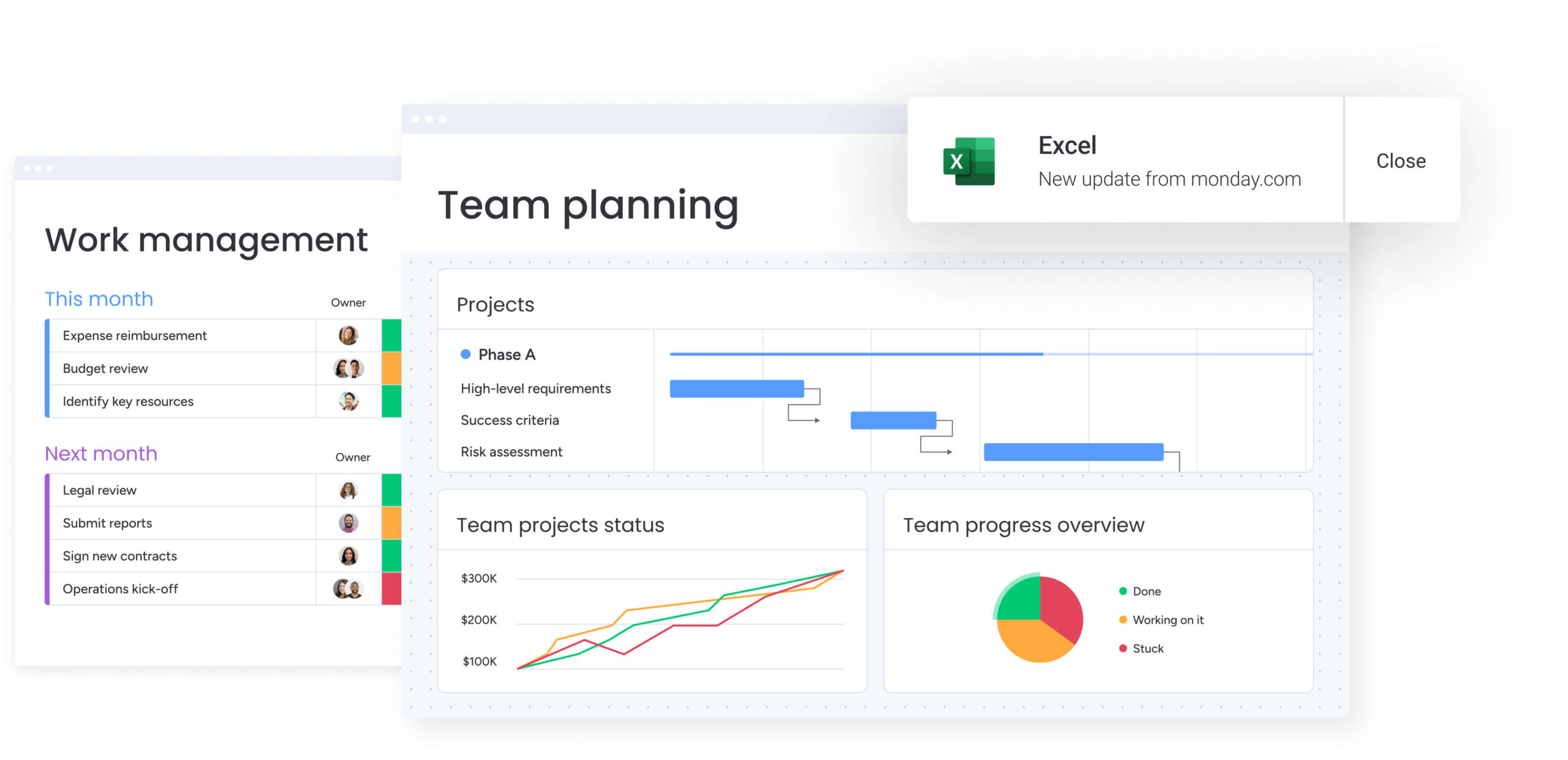
Tired of juggling spreadsheets and disconnected tools that slow down your strategic execution? Traditional methods often create confusion, delays, and mistakes. Using monday work management helps streamline your strategic execution by providing a centralized, intuitive platform for seamless planning, implementation, and progress tracking.
Keep your teams moving together
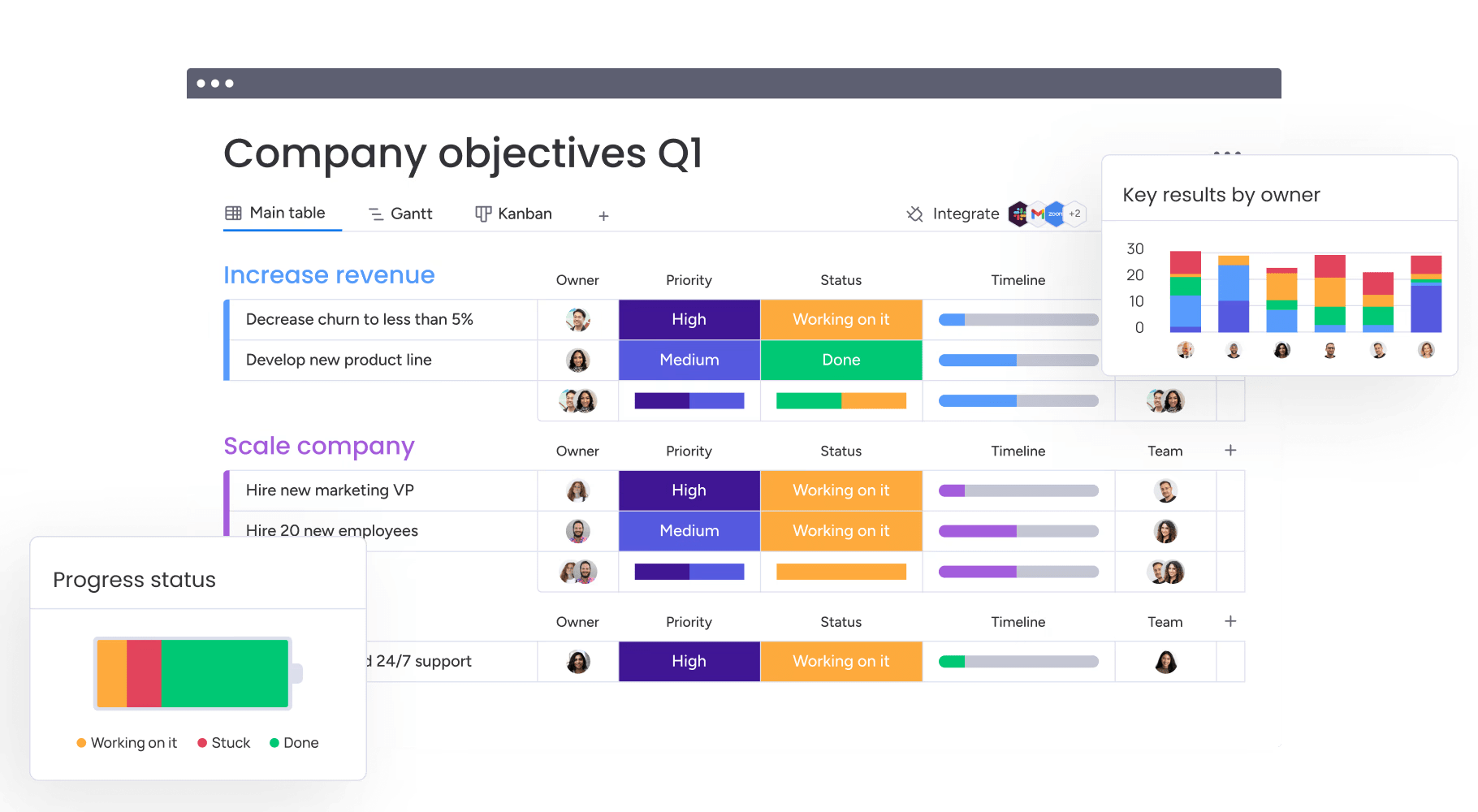
monday work management company objectives board
When departments aren’t aligned, even the strongest strategic execution can get sidetracked. With monday work management, everyone shares an open and obvious path forward.
- Centralize goals: Set clear objectives in one place so everyone knows what’s expected without confusion.
- Simplify workflows: Easy-to-follow templates clarify roles, streamline tasks, and eliminate redundancies.
- Portfolio overview: Quickly view project status across teams, ensuring everyone supports your business objectives.
A coordinated team executes strategies confidently and understands their contributions to overall success.
See exactly what’s happening
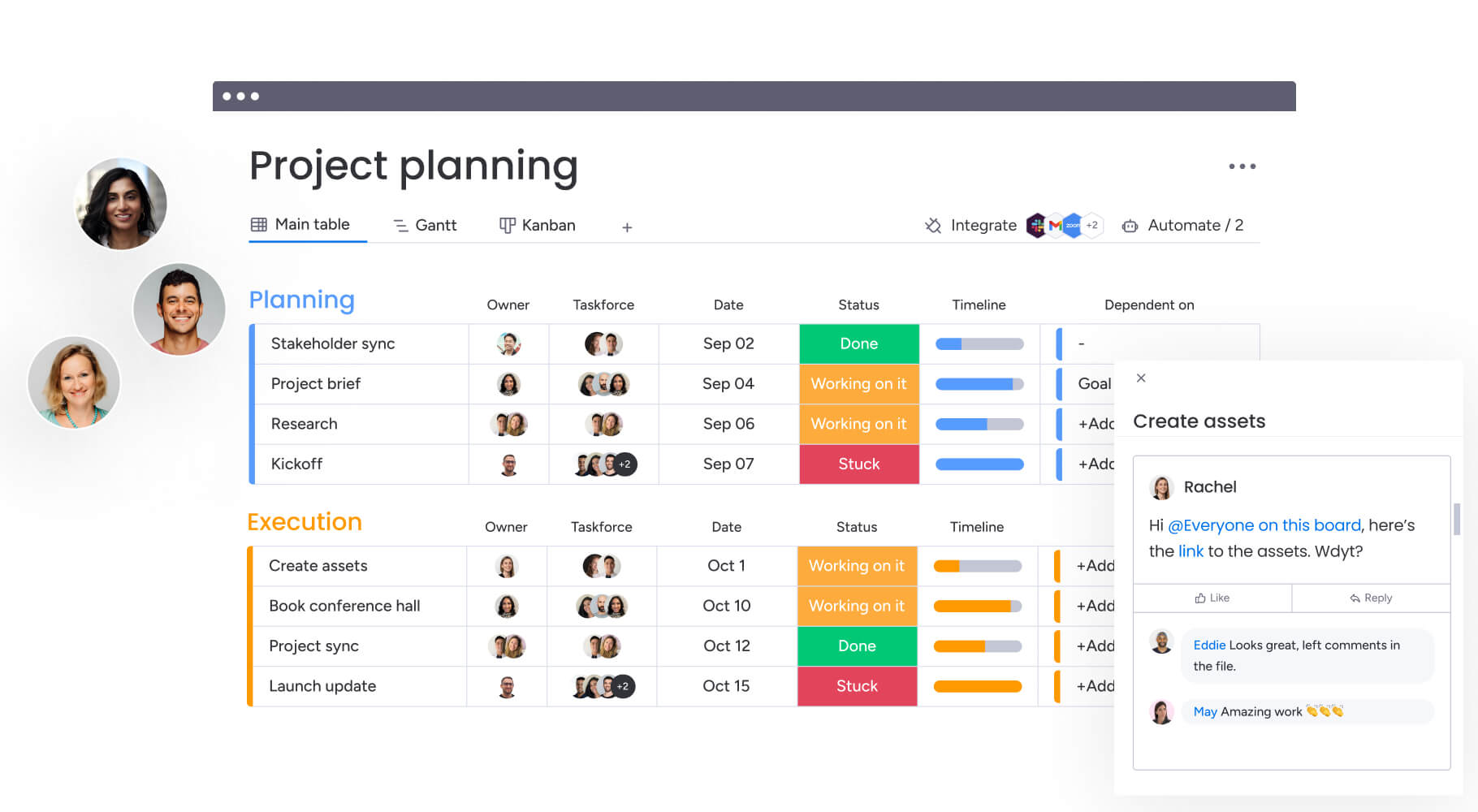
As your business grows, strategic execution becomes more complex. Instant updates from monday work management ensure you stay on top of every important detail:
- Visual dashboards: Spot risks, resource bottlenecks, or project delays, eliminating guesswork from your strategic execution.
- AI-powered risk insights: Automatically identify and proactively manage potential problems.
- Executive summaries: Quick, transparent reports for timely decision-making whenever needed.
With timely insights, your leadership stays proactive and responsive, making informed decisions without delay.
Boost productivity, reduce friction
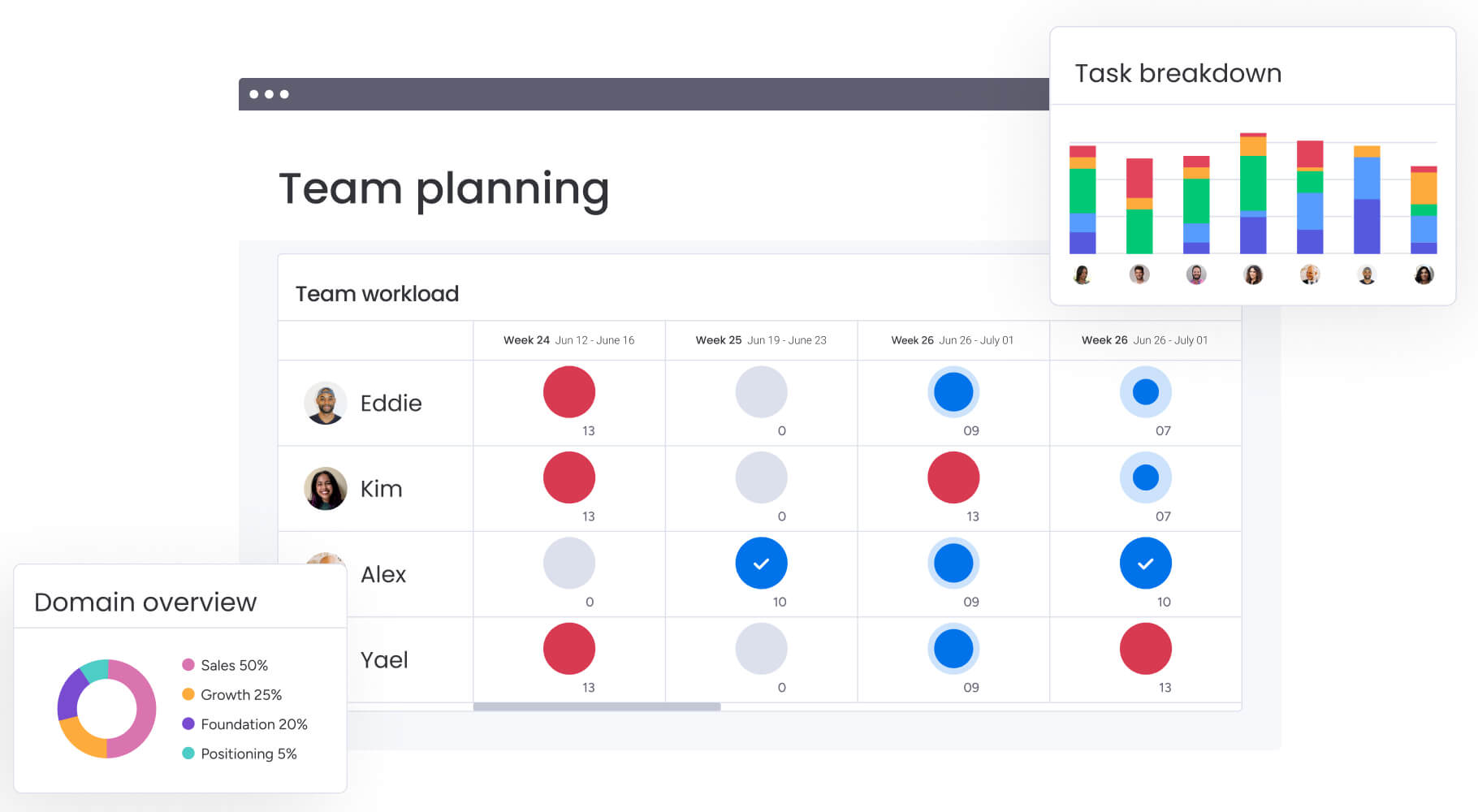
Outdated tools and manual processes impede strategic execution by draining resources and causing delays. Streamline your approach and optimize productivity with monday work management:
- Easy collaboration: Coordinate effortlessly across departments, removing communication barriers.
- Resource optimization: Quickly allocate workloads to prevent burnout, ensuring efficient resource use across all execution efforts.
- Rapid approvals: Standardize your request and approval processes to eliminate bottlenecks.
With simplified processes, your business moves quicker, saves resources, and consistently hits strategic targets.
Ready to streamline your business processes? Read more about how work management can help.
Take your strategic execution to the next level
Ready to transition smoothly from strategy to results? With monday work management, your team has the right tools to simplify day-to-day tasks, stay informed, and adapt quickly. By reducing friction and increasing transparency, you’ll see your strategic plans transform into reality faster.
Explore how monday work management can help you turn strategies into achievements your whole organization can celebrate.
FAQs
What is the difference between strategic planning and strategic execution?
Strategic planning is the process of creating business goals and establishing direction. Strategic execution turns those plans into actionable steps and achieving measurable outcomes.
How can businesses measure successful strategy execution?
Businesses typically measure successful execution through metrics like:
- Goal completion rates
- Time-to-market improvements
- Resource efficiency
- Achievement of project milestones
What are common pitfalls to avoid in strategic execution?
Typical pitfalls include unclear communication, limited visibility, and inefficient workflows. If priorities aren't clearly defined, confusion and delays quickly arise. Without proper tracking, small issues escalate unnoticed. Outdated tools or mismanaged resources further complicate execution, preventing your strategy from delivering results.
Why do companies struggle with cross-functional collaboration during execution?
Cross-functional collaboration often suffers due to communication gaps, department silos, and vague responsibilities. When teams lack clarity about their roles or the bigger picture, they tend to duplicate efforts or overlook crucial tasks. Regular, transparent communication helps unify departments around shared objectives.
How does strategic execution differ from operational or tactical execution?
Strategic execution involves aligning resources and teams around long-term organizational goals. In contrast, operational or tactical execution focuses on short-term tasks, day-to-day activities, and immediate objectives. Understanding this distinction helps organizations balance daily operations with sustained progress toward their broader vision.
 Get started
Get started 

